Neil Shah
RobustL2S: Speaker-Specific Lip-to-Speech Synthesis exploiting Self-Supervised Representations
Jul 03, 2023



Abstract:Significant progress has been made in speaker dependent Lip-to-Speech synthesis, which aims to generate speech from silent videos of talking faces. Current state-of-the-art approaches primarily employ non-autoregressive sequence-to-sequence architectures to directly predict mel-spectrograms or audio waveforms from lip representations. We hypothesize that the direct mel-prediction hampers training/model efficiency due to the entanglement of speech content with ambient information and speaker characteristics. To this end, we propose RobustL2S, a modularized framework for Lip-to-Speech synthesis. First, a non-autoregressive sequence-to-sequence model maps self-supervised visual features to a representation of disentangled speech content. A vocoder then converts the speech features into raw waveforms. Extensive evaluations confirm the effectiveness of our setup, achieving state-of-the-art performance on the unconstrained Lip2Wav dataset and the constrained GRID and TCD-TIMIT datasets. Speech samples from RobustL2S can be found at https://neha-sherin.github.io/RobustL2S/
Evaluating Graph Neural Networks for Link Prediction: Current Pitfalls and New Benchmarking
Jun 18, 2023Abstract:Link prediction attempts to predict whether an unseen edge exists based on only a portion of edges of a graph. A flurry of methods have been introduced in recent years that attempt to make use of graph neural networks (GNNs) for this task. Furthermore, new and diverse datasets have also been created to better evaluate the effectiveness of these new models. However, multiple pitfalls currently exist that hinder our ability to properly evaluate these new methods. These pitfalls mainly include: (1) Lower than actual performance on multiple baselines, (2) A lack of a unified data split and evaluation metric on some datasets, and (3) An unrealistic evaluation setting that uses easy negative samples. To overcome these challenges, we first conduct a fair comparison across prominent methods and datasets, utilizing the same dataset and hyperparameter search settings. We then create a more practical evaluation setting based on a Heuristic Related Sampling Technique (HeaRT), which samples hard negative samples via multiple heuristics. The new evaluation setting helps promote new challenges and opportunities in link prediction by aligning the evaluation with real-world situations. Our implementation and data are available at https://github.com/Juanhui28/HeaRT
CARL-G: Clustering-Accelerated Representation Learning on Graphs
Jun 12, 2023



Abstract:Self-supervised learning on graphs has made large strides in achieving great performance in various downstream tasks. However, many state-of-the-art methods suffer from a number of impediments, which prevent them from realizing their full potential. For instance, contrastive methods typically require negative sampling, which is often computationally costly. While non-contrastive methods avoid this expensive step, most existing methods either rely on overly complex architectures or dataset-specific augmentations. In this paper, we ask: Can we borrow from classical unsupervised machine learning literature in order to overcome those obstacles? Guided by our key insight that the goal of distance-based clustering closely resembles that of contrastive learning: both attempt to pull representations of similar items together and dissimilar items apart. As a result, we propose CARL-G - a novel clustering-based framework for graph representation learning that uses a loss inspired by Cluster Validation Indices (CVIs), i.e., internal measures of cluster quality (no ground truth required). CARL-G is adaptable to different clustering methods and CVIs, and we show that with the right choice of clustering method and CVI, CARL-G outperforms node classification baselines on 4/5 datasets with up to a 79x training speedup compared to the best-performing baseline. CARL-G also performs at par or better than baselines in node clustering and similarity search tasks, training up to 1,500x faster than the best-performing baseline. Finally, we also provide theoretical foundations for the use of CVI-inspired losses in graph representation learning.
Demystifying Structural Disparity in Graph Neural Networks: Can One Size Fit All?
Jun 02, 2023



Abstract:Recent studies on Graph Neural Networks(GNNs) provide both empirical and theoretical evidence supporting their effectiveness in capturing structural patterns on both homophilic and certain heterophilic graphs. Notably, most real-world homophilic and heterophilic graphs are comprised of a mixture of nodes in both homophilic and heterophilic structural patterns, exhibiting a structural disparity. However, the analysis of GNN performance with respect to nodes exhibiting different structural patterns, e.g., homophilic nodes in heterophilic graphs, remains rather limited. In the present study, we provide evidence that Graph Neural Networks(GNNs) on node classification typically perform admirably on homophilic nodes within homophilic graphs and heterophilic nodes within heterophilic graphs while struggling on the opposite node set, exhibiting a performance disparity. We theoretically and empirically identify effects of GNNs on testing nodes exhibiting distinct structural patterns. We then propose a rigorous, non-i.i.d PAC-Bayesian generalization bound for GNNs, revealing reasons for the performance disparity, namely the aggregated feature distance and homophily ratio difference between training and testing nodes. Furthermore, we demonstrate the practical implications of our new findings via (1) elucidating the effectiveness of deeper GNNs; and (2) revealing an over-looked distribution shift factor on graph out-of-distribution problem and proposing a new scenario accordingly.
MParrotTTS: Multilingual Multi-speaker Text to Speech Synthesis in Low Resource Setting
May 19, 2023



Abstract:We present MParrotTTS, a unified multilingual, multi-speaker text-to-speech (TTS) synthesis model that can produce high-quality speech. Benefiting from a modularized training paradigm exploiting self-supervised speech representations, MParrotTTS adapts to a new language with minimal supervised data and generalizes to languages not seen while training the self-supervised backbone. Moreover, without training on any bilingual or parallel examples, MParrotTTS can transfer voices across languages while preserving the speaker-specific characteristics, e.g., synthesizing fluent Hindi speech using a French speaker's voice and accent. We present extensive results on six languages in terms of speech naturalness and speaker similarity in parallel and cross-lingual synthesis. The proposed model outperforms the state-of-the-art multilingual TTS models and baselines, using only a small fraction of supervised training data. Speech samples from our model can be found at https://paper2438.github.io/tts/
Link Prediction with Non-Contrastive Learning
Nov 25, 2022Abstract:A recent focal area in the space of graph neural networks (GNNs) is graph self-supervised learning (SSL), which aims to derive useful node representations without labeled data. Notably, many state-of-the-art graph SSL methods are contrastive methods, which use a combination of positive and negative samples to learn node representations. Owing to challenges in negative sampling (slowness and model sensitivity), recent literature introduced non-contrastive methods, which instead only use positive samples. Though such methods have shown promising performance in node-level tasks, their suitability for link prediction tasks, which are concerned with predicting link existence between pairs of nodes (and have broad applicability to recommendation systems contexts) is yet unexplored. In this work, we extensively evaluate the performance of existing non-contrastive methods for link prediction in both transductive and inductive settings. While most existing non-contrastive methods perform poorly overall, we find that, surprisingly, BGRL generally performs well in transductive settings. However, it performs poorly in the more realistic inductive settings where the model has to generalize to links to/from unseen nodes. We find that non-contrastive models tend to overfit to the training graph and use this analysis to propose T-BGRL, a novel non-contrastive framework that incorporates cheap corruptions to improve the generalization ability of the model. This simple modification strongly improves inductive performance in 5/6 of our datasets, with up to a 120% improvement in Hits@50--all with comparable speed to other non-contrastive baselines and up to 14x faster than the best-performing contrastive baseline. Our work imparts interesting findings about non-contrastive learning for link prediction and paves the way for future researchers to further expand upon this area.
Linkless Link Prediction via Relational Distillation
Oct 19, 2022

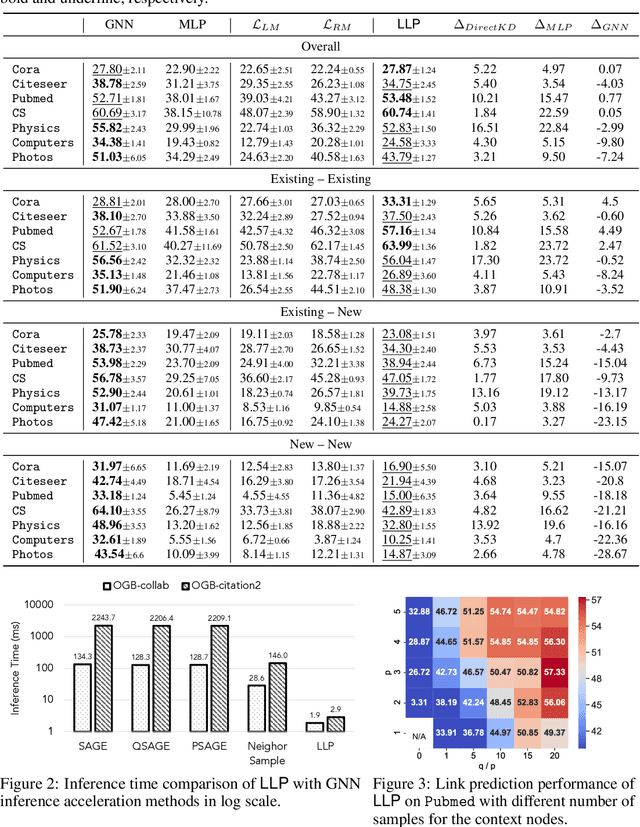
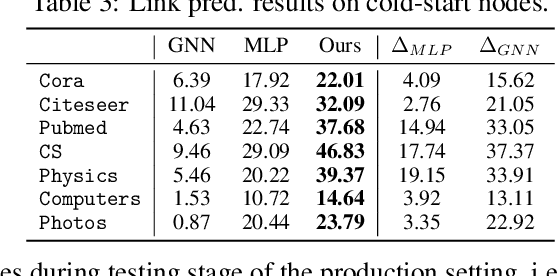
Abstract:Graph Neural Networks (GNNs) have been widely used on graph data and have shown exceptional performance in the task of link prediction. Despite their effectiveness, GNNs often suffer from high latency due to non-trivial neighborhood data dependency in practical deployments. To address this issue, researchers have proposed methods based on knowledge distillation (KD) to transfer the knowledge from teacher GNNs to student MLPs, which are known to be efficient even with industrial scale data, and have shown promising results on node classification. Nonetheless, using KD to accelerate link prediction is still unexplored. In this work, we start with exploring two direct analogs of traditional KD for link prediction, i.e., predicted logit-based matching and node representation-based matching. Upon observing direct KD analogs do not perform well for link prediction, we propose a relational KD framework, Linkless Link Prediction (LLP). Unlike simple KD methods that match independent link logits or node representations, LLP distills relational knowledge that is centered around each (anchor) node to the student MLP. Specifically, we propose two matching strategies that complement each other: rank-based matching and distribution-based matching. Extensive experiments demonstrate that LLP boosts the link prediction performance of MLPs with significant margins, and even outperforms the teacher GNNs on 6 out of 9 benchmarks. LLP also achieves a 776.37x speedup in link prediction inference compared to GNNs on the large scale OGB-Citation2 dataset.
A Practical, Progressively-Expressive GNN
Oct 18, 2022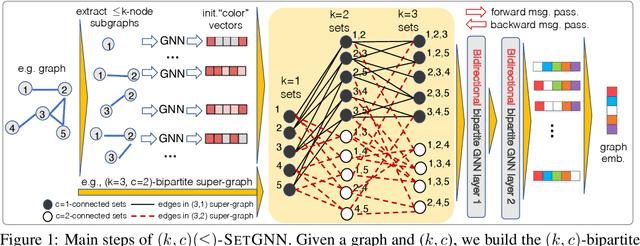


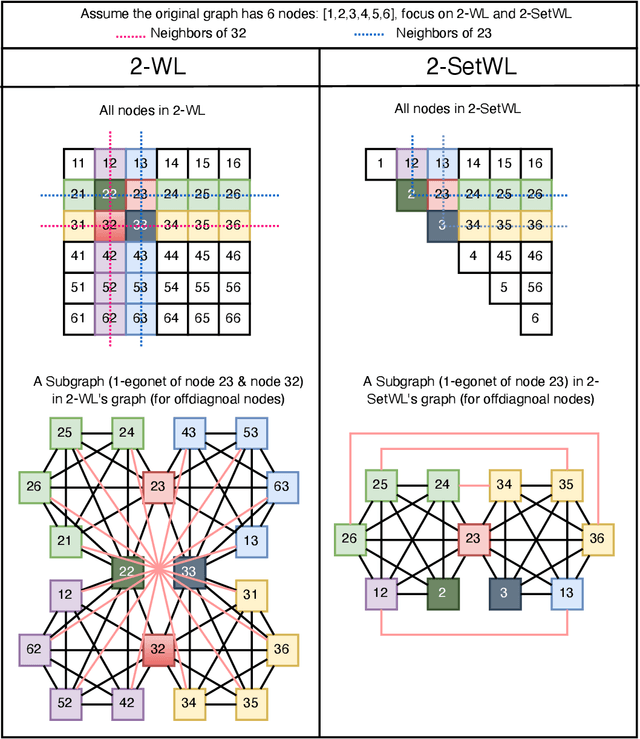
Abstract:Message passing neural networks (MPNNs) have become a dominant flavor of graph neural networks (GNNs) in recent years. Yet, MPNNs come with notable limitations; namely, they are at most as powerful as the 1-dimensional Weisfeiler-Leman (1-WL) test in distinguishing graphs in a graph isomorphism testing frame-work. To this end, researchers have drawn inspiration from the k-WL hierarchy to develop more expressive GNNs. However, current k-WL-equivalent GNNs are not practical for even small values of k, as k-WL becomes combinatorially more complex as k grows. At the same time, several works have found great empirical success in graph learning tasks without highly expressive models, implying that chasing expressiveness with a coarse-grained ruler of expressivity like k-WL is often unneeded in practical tasks. To truly understand the expressiveness-complexity tradeoff, one desires a more fine-grained ruler, which can more gradually increase expressiveness. Our work puts forth such a proposal: Namely, we first propose the (k, c)(<=)-SETWL hierarchy with greatly reduced complexity from k-WL, achieved by moving from k-tuples of nodes to sets with <=k nodes defined over <=c connected components in the induced original graph. We show favorable theoretical results for this model in relation to k-WL, and concretize it via (k, c)(<=)-SETGNN, which is as expressive as (k, c)(<=)-SETWL. Our model is practical and progressively-expressive, increasing in power with k and c. We demonstrate effectiveness on several benchmark datasets, achieving several state-of-the-art results with runtime and memory usage applicable to practical graphs. We open source our implementation at https://github.com/LingxiaoShawn/KCSetGNN.
Forget Unlearning: Towards True Data-Deletion in Machine Learning
Oct 17, 2022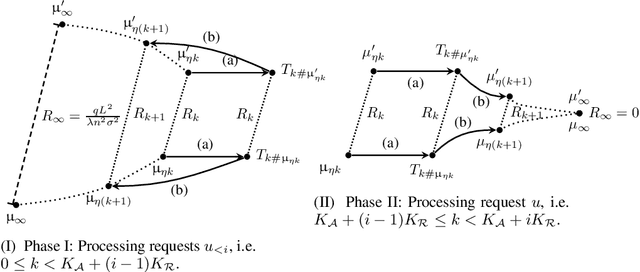
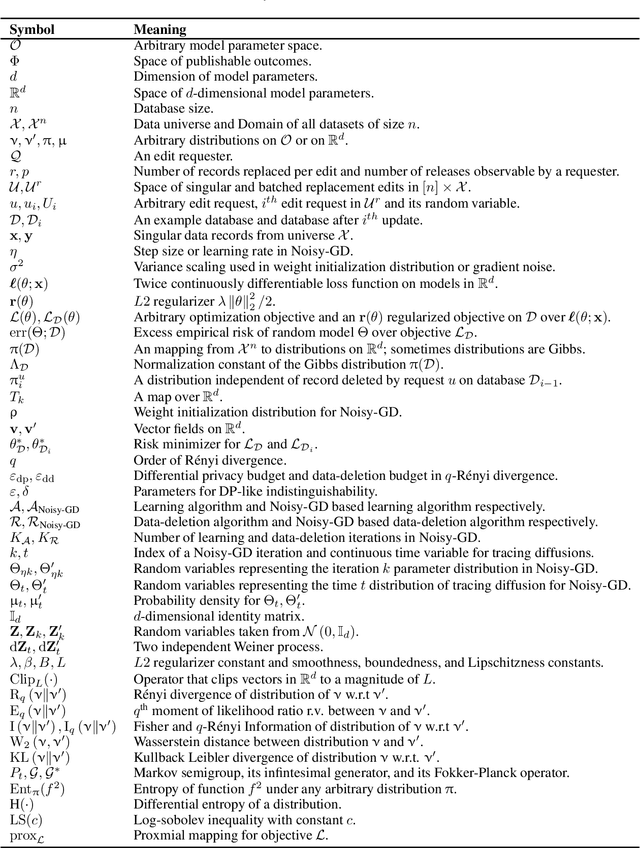
Abstract:Unlearning has emerged as a technique to efficiently erase information of deleted records from learned models. We show, however, that the influence created by the original presence of a data point in the training set can still be detected after running certified unlearning algorithms (which can result in its reconstruction by an adversary). Thus, under realistic assumptions about the dynamics of model releases over time and in the presence of adaptive adversaries, we show that unlearning is not equivalent to data deletion and does not guarantee the "right to be forgotten." We then propose a more robust data-deletion guarantee and show that it is necessary to satisfy differential privacy to ensure true data deletion. Under our notion, we propose an accurate, computationally efficient, and secure data-deletion machine learning algorithm in the online setting based on noisy gradient descent algorithm.
Empowering Graph Representation Learning with Test-Time Graph Transformation
Oct 07, 2022
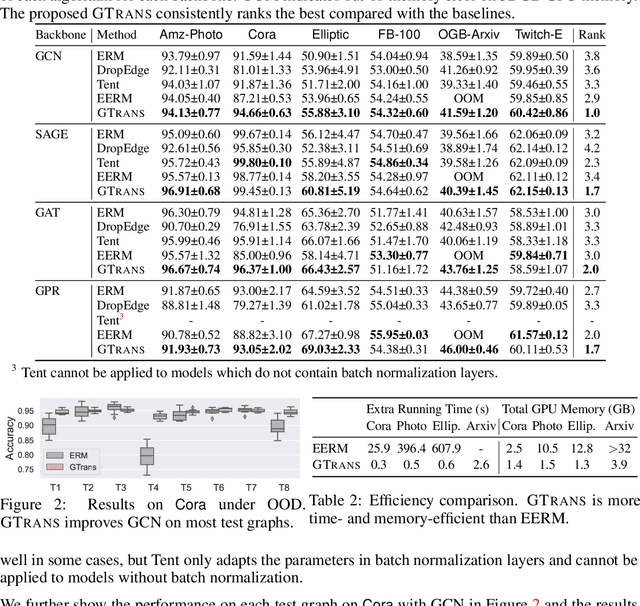
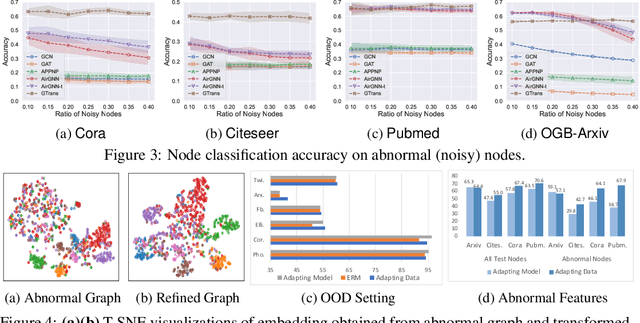

Abstract:As powerful tools for representation learning on graphs, graph neural networks (GNNs) have facilitated various applications from drug discovery to recommender systems. Nevertheless, the effectiveness of GNNs is immensely challenged by issues related to data quality, such as distribution shift, abnormal features and adversarial attacks. Recent efforts have been made on tackling these issues from a modeling perspective which requires additional cost of changing model architectures or re-training model parameters. In this work, we provide a data-centric view to tackle these issues and propose a graph transformation framework named GTrans which adapts and refines graph data at test time to achieve better performance. We provide theoretical analysis on the design of the framework and discuss why adapting graph data works better than adapting the model. Extensive experiments have demonstrated the effectiveness of GTrans on three distinct scenarios for eight benchmark datasets where suboptimal data is presented. Remarkably, GTrans performs the best in most cases with improvements up to 2.8%, 8.2% and 3.8% over the best baselines on three experimental settings.
 Add to Chrome
Add to Chrome Add to Firefox
Add to Firefox Add to Edge
Add to Edge